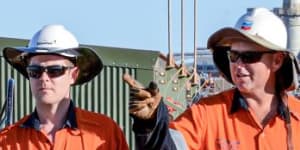Carbon capture and storage traps emissions released when gas is extracted or fossil fuels are burned for energy,and injects them underground. But the Greens and some climate action advocates say the technology prolongs the use of fossil fuels and delays investment in clean,renewable energy.

Chevron’s carbon capture and storage project at the Gorgon LNG site in WA has fallen short of targets.Chevron
From July 1,the will force the 215 biggest polluters,including gas producers,fertiliser plants and cement manufacturers,to cut their emissions by a cumulative 28.5 per cent by 2030.
Global resources analyst Wood Mackenzie said the scheme would boost investor confidence in carbon capture and storage (CCS).
“Changes to the safeguard mechanism will have a direct impact on gas producers looking to develop CCS projects in Australia,” Wood Mackenzie research analyst Anna Forbes said.
“CCS’s route to a viable revenue stream is clearer and getting financial backing will potentially become easier.
“I suspect this policy will generate a proliferation of CCS projects in Australia because not only will[gas] producers need abatement solutions,but so will all the other big industrial and mining emitters subject to the mechanism.”
According to Wood Mackenzie data,27 carbon capture and storage projects have either been proposed or are under development in Australia.
Gas giant Chevron gained approval in 2016 for its massive Gorgon gas plant in Western Australia on the condition it captures and stores underground 80 per cent of the pollution it generates when greenhouse gas leaks during extraction and from burning gas to fuel its processing plant. However,carbon capture and storage is still
Santos is set to start a carbon capture and storage project next year at its Moomba production hub in South Australia and is working on another in the Timor Sea that could reinject under the seabed emissions from its proposed Barossa gas project off Australia’s northern coast.
The federal government has struck a deal with the Greens on its major climate change commitment after months of negotiations.
The former Coalition government attempted in 2021 to change the laws governing the Commonwealth’s green bank,the Clean Energy Finance Corporation,to permit it to fund carbon capture and storage projects but was blocked by the Senate.
Santos chairman Keith Spence told shareholders on Thursday that carbon capture and storage was critical to Australia’s ability to achieve net-zero emissions and warned industry would struggle to develop large-scale projects like Barossa without government support.
The company’s chief executive,Kevin Gallagher,said the United States had committed $10 billion to developing and deploying the technology,as well as offering tax credits of up to $85 a tonne of emissions saved.
Companies affected by the safeguard mechanism currently generate about 140 million tonnes of greenhouse gas a year.
The International Energy Agency calculates global carbon capture and storage is currently capturing only 45 million tonnes of emissions a year,with projects being built or in planning projected to have capacity to capture just 230 million tonnes by 2030.
The agency says the use of the technology needs to ramp up massively to help the world achieve the Paris Agreement goal of limiting warming to 1.5 degrees and reach net-zero emissions by 2050.
“The scale of the climate challenge means we need to act across a wide range of energy technologies. Carbon capture is critical for ensuring our transitions to clean energy are secure and sustainable,” the agency’s executive director,Fatih Birol,said.
Cut through the noise of federal politics with news,views and expert analysis from Jacqueline Maley..